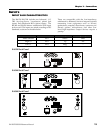
Connections: Chapter 2
16 RA150/300/500 Reference Manual
BALANCED OR UNBALANCED?
With long cable runs (e.g., over 6 meters/20 feet) in
noisy electrical environments, the cable itself can act
as an “antenna” and pick up RF fields, AC hum, or
other types of interference. To avoid these
problems, many professional studios and live sound
companies use balanced line connections. The
average application will probably not require
balanced lines, but using balanced connectors
between the mixer and the RA150/300/500 means
one less possibility for ground loops and hum
elsewhere in the system.
Balanced lines carry a pair of signals, each out of
phase with respect to the other but otherwise
identical. To be converted back into a single,
unbalanced line, both balanced lines feed a
differential amplifier input or transformer that
responds to the difference in levels between signals.
Thus, the out-of-phase signals are recombined into
an unbalanced signal, but interference induced into
the cable will not be out of phase. Since there is no
difference between these signals, the differential
amplifier or transformer will reject the interference
to a great degree. This tendency to ignore
interference is called Common Mode Rejection.
To connect a balanced line output to
feed the RA150/300/500:
You have two options:
TRS-to-TRS cable
Most modern mixing consoles, such as the Alesis
Studio 32, feature balanced outputs on 1/4" TRS
jacks. This is the same balancing connector used by
the RA150/300/500. Get a 3-conductor cable with a
1/4" male TRS connector at each end.
XLR-to-XLR cable
A slightly more expensive balanced connector is the
XLR type, most commonly sold as a "microphone
cable". The main advantage of this is that the
connector locks in place, making it more resistant to
accidental disconnection. If your mixing console
has XLR outputs, and you have the RA300 or RA500
amplifier, you may connect it with an XLR female to
XLR male cable. (The mixer will have an XLR male
jack, the amp has an XLR female jack.)
If you have the RA150, which doesn't have an XLR
input, you may use an XLR-F to TRS-M cable
or adapter. The 1/4" input jack of the RA150 is
balanced. (See Figure 5 on page 17.)
To connect an unbalanced source to
the amplifier input:
Unbalanced cable
Simply use a standard, shielded 1/4" patch cord.
Or, if the source has an RCA/phono output, use a
shielded phono-to-phono cable.
Unbalanced-to-balanced cable with
telescoping shield
In some installations, you may be able to eliminate a
ground loop even though the source is unbalanced
by wiring a cable or adapter that has the shield
connected at only the unbalanced end, using the
inner conductor wires to carry the "hot" signal to
pin 2 and the ground to pin 3 of the
RA150/300/500. This may keep any ground
potential difference between the source and the
amplifier out of the signal path. The following
diagram shows an adapter that assumes pin 2 of the
XLR connector is “hot”; note that the shield of the
phone jack is NOT connected to pin 1 (the ground of
the amplifier), but is left floating (disconnected).
1 (float)
2 (hot)
3
(
cold
)
Male XLR
Connector
1/4 "
p
hone
j
ack
If you have an RA150 without an XLR input, then
make a 1/4" mono to 1/4" TRS adapter. Wire the
"hot" of the input signal to the tip, the
shield/ground to the ring, and leave the sleeve
disconnected at the RA150.


















